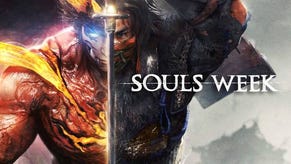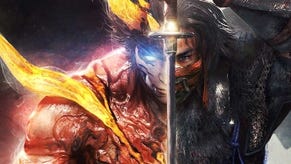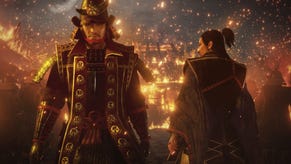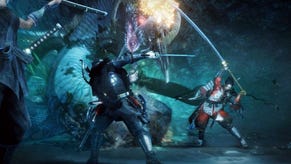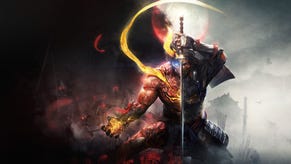Nioh 2 hands-on: how Team Ninja polishes and refines its winning formula
Alpha code reveals a solid 60fps mode plus an impressive HDR upgrade.
Nioh is returning for PlayStation 4 owners in the form of a brand new sequel and this week's alpha test reveals a game that carries over much from the original, while delivering some welcome refinements. And just like the first game, it's a tough-as-nails action game, borrowing liberally from the Dark Souls formula while offering its own unique features. While the code we're looking at today is flagged as alpha, you'd never know from looking at it - it's already polished and refined to the point where it feels almost like a shipping product.
Like the original, Nioh 2 is not a stunning game at first glance, but give it time and its more subdued visual style begins to grow on you. The demo depicts a dilapidated village encircled by vast mountains, while the sun hangs low on the horizon, casting long shadows across its dangerous world. It makes a strong first impression and, while it appears instantly reminiscent of the original, it soon becomes clear that the team has refined its presentation.
Straight away, the lighting feels like a step up from the original with more dramatic use of sun and shadow. In addition, the overall stage design is more refined with plenty of fine detail spread throughout. It's not quite on par with From Software's recent Sekiro in terms of overall density, but it's still an attractive game and of course, it targets much higher performance levels. In addition, there's a rather good HDR solution that really pushes dynamic range - a new feature to the Nioh series, which only shipped with SDR rendering in its debut release.
There are plenty of similarities to the original game, though. For example, users get to choose between resolution and image quality rendering options, this time with three distinct modes: action, movie and movie mode variable. This kind of choice is usually reserved for the enhanced consoles, but once again, Nioh 2 offers all modes to both base and Pro hardware users - and the differences are fascinating.
The default preset is action mode, where the game pares back resolution and some rendering features in order to deliver as close to a locked 60 frames per second as possible. Dynamic resolution is in play to help stabilise performance, with base consoles mostly delivering a 720p image, while Pro targets 1080p, though in both cases, pixel counts vary above and below. Image quality isn't this game's strong suit, as the anti-aliasing technique isn't especially effective and there is plenty of shimmering. However, visual issues aside, I feel that this is the best way to play game - 60fps on a fast-paced action game makes all the difference.
Movie mode caps performance to 30 frames per second, with the vanilla console mostly locked to 1080p, while the Pro uses a reconstruction technique to deliver a higher quality 1800p better suited for users of 4K displays. What I liked about the mode selector in Nioh 2 as that unlike the first game, you can switch between them and see the results change before your eyes in real-time. The most obvious difference seems to be the variation in terrain quality - the movie mode appears to use a form of tessellation that is disabled in action mode, while some of the dynamic shadows appear to be animated vs static shadows at 60fps.
Some effects are hard locked regardless of your gameplay mode. For example, screen-space reflections are identical on both, while a cool procedural cloud system is also left running on all systems in all modes. Ultimately, there are some rough edges but the overall look of the game is effective, especially when entering the Yokai realm where all sorts of effects are thrown at the screen to dramatic effect.
>>Despite the pared back resolution and effects work, it's still the action mode that I've prefered to play. It promises 60fps and on PS4 Pro, it's virtually locked. Team Ninja has always focused on hitting 60fps but in actual fact, Nioh 2 seems to maintain this better than most of their previous titles. It's really super smooth - with only minor blips when tested on the base console. It's smooth but not as smooth as it could be, despite the massive drop in resolution. Still, the game is incomplete and we saw noticeable improvements between the original demo for Nioh and the final code, so the team still has time to overcome these issues.
And hopefully that time can also be used to whip the movie mode into shape. The drop from 60fps to 30fps already feels quite profound, but the truth is that the PS4 Pro can even drop beneath the half-refresh performance target. Another problem carried over from the first Nioh also hasn't been corrected: there is an inherent judder present in movie mode, which seems to be caused by a camera which updates at variable intervals leading to a somewhat jerky-feeling experience. Movie mode variable? It's just like the standard version with an unlocked frame-rate - not really the way I want to play the game as it falls way short of 60fps.
An often overlooked aspect of performance concerns loading times - which just happens to be one of the most impressive aspects of Nioh 2. You will die a lot and thankfully, loading when this happens is extremely short: everything happens within a handful of seconds.
Based on what we've seen so far, Nioh 2 is shaping up as a solid sequel that perhaps plays it a little too safely, but that's OK - the original is one of the better action games of the generation and I'm eager to see what Nioh 2 ultimately delivers when it launches. If Team Ninja can cut down some of the grindy elements that persisted in the original, this could be an even better game.



